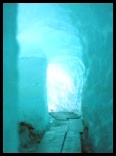
 Drilling for... Ice? In some places, like the Arctic and Antarctic, the temperature is so cold, most of the snow that falls doesn't melt. It just accumulates, layer upon layer, year after year - and gradually turns to ice.
The deepest part of the ice in glaciers and ice sheets may have fallen as snow thousands and thousands of years ago, and the particles locked in it form a record of the Earth's atmosphere at that time. By drilling or tunnelling into the ice and analyzing core samples, scientists can learn about past air quality, temperature changes, and types of vegetation.
Click pictures for more information and credits. Library: Arctic, Ice, Snow, Glaciers, Icebergs Links: Arctic, Glaciers, Ice Age, Cold Places Arctic Maps & Weather Reports |

|
DICTIONARY: Just "double-click" any unlinked word on this page for the definition from Merriam-Webster's Student Electronic Dictionary at Word Central. |

|
ARCTIC LIBRARY & GLOSSARY: Check this section for an index of the rest of the things you really need to know about the Arctic. |

|
ARCTIC MAPS & WEATHER REPORTS: Maps of the Northwest Passage, explorers' routes, iceberg sources, Nunavut, the Arctic by treeline, temperature... |

|
ARCTIC LINKS: Even more information! Links to sites related to the Arctic and "Iceberg: the Story of the Throps and the Squallhoots". |

|
GUIDE TO ARCTIC SUNRISE & SUNSET: How much sunlight or darkness is there in the Arctic on each day of the year? |
to is the property of their respective owners, and Athropolis is not responsible for their content.
